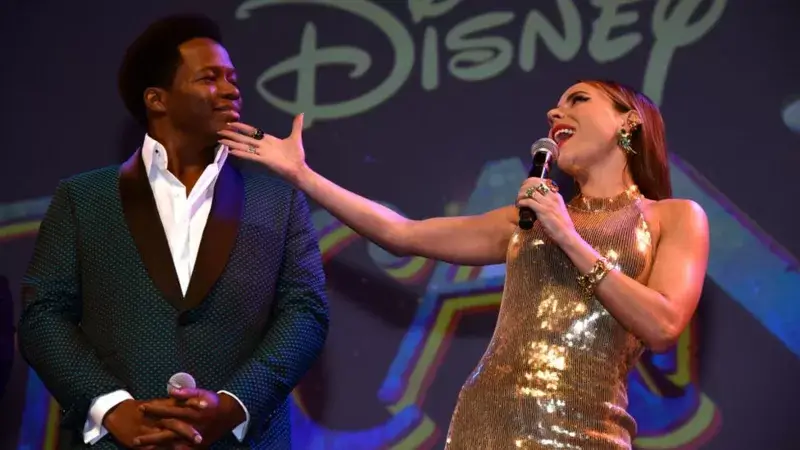The song We don't talk about Bruno , from the Disney movie “Encanto”, managed to reach the top of the charts in the United States, sharing the podium with artists such as Adele and Glass Animals, while also being positioned as number one in the UK.
The theme is so catchy that thousands of people have uploaded videos to TikTok singing and dancing with it in the background.
In fact, it has surpassed the success of the song Let it go from the Disney movie Frozen a few years ago, reaching number 4 on the Billboard chart ( Let it go reached 5th).
The funny thing is that, apparently, Disney did not think that the impact of the song was going to be so great, so he decided to nominate another theme of "Enchantment" for the Oscars.
Advertising
What is the secret to the success of We don't talk about Bruno ? Here we give you three reasons that can explain it.
1. The theme
We don't talk about Bruno was adapted as “No se Habla de Bruno” for the Spanish version and is the theme that identifies the mysterious character of “Encanto”.
This is Bruno, the clairvoyant uncle that no one talks about in public and that reflects the typical family theme that is an open secret and generates controversy, so he emphatically avoids during dinner.
The song recreates that dynamic and does so using very graphic words and scenes.
"Children have always liked chilling, half-dark songs, and this one says, for example: 'Terror on their face, rats behind, when they hear your name there is no going back,'" Mauro Castillo explains to BBC Mundo, independent musician and one of the main voices of the song.
This component of mystery is reinforced by the inclusion of other characters in the film who tell their experiences or anecdotes with Uncle Bruno. In the end, a song of many voices that almost fight each other in a very dynamic choral story is achieved.
Advertising
Its composer, Lin-Manuel Miranda, who has extensive experience in the musicalization of theatrical and cinematographic creations, has said that he was inspired by the theater.
“What he was trying to do is much more common in musical theater than it is in movie musicals. You have those great moments where everyone gets a little masterpiece and then you merge them together. I think of One Day More from 'Les Miserables' or Non-Stop from 'Hamilton'. It's always a lovely moment when you can layer all the themes on each other," Miranda said in a recent interview.
2. The diversity of sounds
This is a difficult song to pigeonhole due to the multiplicity of voices, rhythms and scenes that make it up.
The composition “managed to unite the theme, rescuing the montuno rhythm with chachachá. Over there you can hear a happy drum, but there is also influence from rap and trap”, explains Castillo.
And according to him, it is precisely this mixture that has conquered millions of ears. “I think people were expecting more from the Latin urban scene. There is an interest in other types of sounds beyond the reggaeton chicapum”.
“This song, for example, is in a tempo that tends to seduce those who dance, who like to move. It's a rather relaxed tempo and makes it easy to move one foot and then the other," he adds.
The mix can also be understood as a kind of deconstruction of the more traditional percussion. “You feel a drum from time to time that is slow, not as fast as what we are used to in Latin America. In this song it is suggested, it is not as textual as when it is present in the loop that is put together in a sauce,” clarifies the musician.
So the success of the song may also lie in the fact that people not only want to sing and perform the song, but also that it allows them to dance and easily enter party and celebration mode.
3. The industry behind the song
Although a song has all the potential to go viral, it is not easy to achieve it.
In this case, "Disney has the infrastructure to sweep consumption because it is the largest family entertainment company and even so it never ceases to amaze that it can achieve such resounding successes," writer and music journalist Juan Carlos Garay told BBC Mundo.
In addition, We don't talk about Bruno and the music of “Encanto” in general have also benefited from the digital ecosystem.
“I consider that within the context of Disney there are much older songs that surpass this song in quality, but they belong to another era. Now what happens is that there are greater possibilities of impacting and measuring audiences”, he adds.
In the end, it is a song that has generated a lot of interest regardless of the age of the audience, but that is also covered by a much larger product that has been adapted into different languages, with great exposure in the global press and with renowned artists promoting it. in social networks.
But while the song and soundtrack have been overwhelmingly successful, another discussion has arisen about the representation of Colombian music in the music of “Encanto”.
After the success of Coco , the Disney movie inspired by Mexico, in which a clear homage was made to the traditional rhythms of that country, the expectations placed on Colombia were very high.
the local critic
Although "Encanto" has been very well received in Colombia and in general the tribute paid to the country and its multiculturalism has been celebrated, for some Colombian critics and musicians, the music, on the other hand, does not fully reflect the sound richness of the country.
One of them is the singer María Mulata , who expressed her opinion on Facebook. Although she believes that the film is very valuable and very well produced, she would have liked to “find more Colombian rhythms, more faithful”, without this meaning losing the international tint.
He also emphasizes that in the case of Coco , "there is a faithful presence of the son jarocho, the bolero and the ranchera, with Mexico being a less diverse country than Colombia in terms of rhythms."
This is shared by Garay: "I saw the film with my children and I felt like I was in a musical with small touches of accordion or four llanero to give color, but with a very timid exploration, if it was intended to show Colombian musical folklore" , he concludes.
From the soundtrack of the film, the song that has been perceived, in some way, as more Colombian is “Colombia, my charm” .
That main theme, composed by Miranda and performed by Carlos Vives , has a clear influence from the latter's music, which as he himself says is not folkloric, but is inspired by traditional Colombian rhythms.

